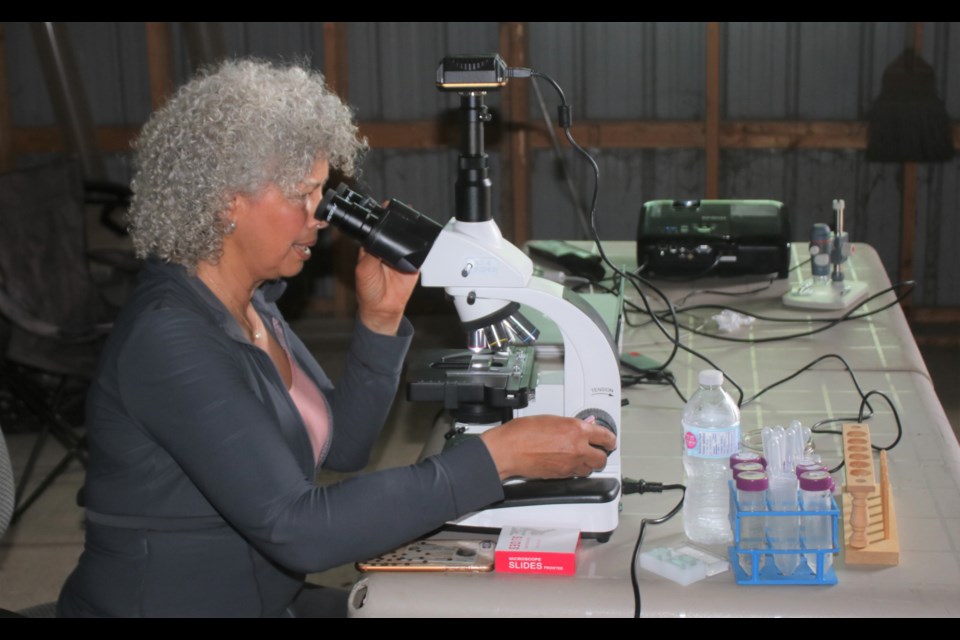To grow a good crop, you need healthy soil.
To have healthy soil you have to understand the diverse ecosystem which exists below the soil surface.
That was the message producers received from Dr. Yamily Zavala of CARA Soil Health Lab in Alberta as she made a presentation at the Friendly Acres Seed Farm Field Day south of Saltcoats last week.
“It’s a new world,” she said. “There’s always something that’s happening.”
Zavala said she is particularly interested in nematodes, and their importance in the soil ecosystem.
For those unfamiliar with nematodes they “arenon-segmented worms typically 1/500 of an inch (50 µm) in diameter and 1/20 of an inch (1 mm) in length. Those few species responsible for plant diseases have received a lot of attention, but far less is known about the majority of the nematode community that plays beneficial roles in soil,” explains the page at www.nrcs.usda.gov
“An incredible variety of nematodes function at several trophic levels of the soil food web. Some feed on the plants and algae (first trophic level); others are grazers that feed on bacteria and fungi (second trophic level); and some feed on other nematodes (higher trophic levels).”
The site notes free-living nematodes can be divided into four broad groups based on their diet.
Bacterial-feedersconsume bacteria.
Fungal-feedersfeed by puncturing the cell wall of fungi and sucking out the internal contents.
Predatory nematodeseat all types of nematodes and protozoa. They eat smaller organisms’ whole, or attach themselves to the cuticle of larger nematodes, scraping away until the prey’s internal body parts can be extracted.
Omnivores eat a variety of organisms or may have a different diet at each life stage. Root-feeders are plant parasites, and thus are not free-living in the soil.
While not all nematodes are beneficial, Zavala said more study is required to fully understand what they mean in terms of maintaining a healthy soil ecosystem.
“Each creature there has a function in the soil,” she said.
Kevin Elmy, host of the field day, said often modern farming techniques can negatively impact the actions which are natural to the soil.
For example certain processes can be slowed because of the addition of fertilizers, and suddenly the normal system is impacted at the microbiological level.
Zavala said her interest in nematodes is part of a larger interest in understanding soil health.
The CARA Soil Health Lab website details that, “soil health is the capacity of soil to function as a living system, with ecosystem and land use boundaries, to sustain plant and animal productivity, maintain or enhance water and air quality, and promote plant and animal health. Healthy soils maintain a diverse community of soil organisms that help to control plant disease, insect and weed pests, form beneficial symbiotic associations with plant roots; recycle essential plant nutrients; improve soil structure with positive repercussions for soil water and nutrient holding capacity, and ultimately improve crop production. A healthy soil does not pollute its environment and does contribute to mitigating climate change by maintaining or increasing its carbon content."
Of course soil health is seen as critical in terms of food production.
“Soil health has been defined as the capacity of soil to function as a living system,” noted the Food and Agriculture Organization of the United Nations. “Healthy soils maintain a diverse community of soil organisms that help to control plant disease, insect and weed pests, form beneficial symbiotic associations with plant roots, recycle essential plant nutrients, improve soil structure with positive effects for soil water and nutrient holding capacity, and ultimately improve crop production.”
CARA notes, healthy soils have many benefits. One of the most important benefits is that healthy soil holds more water (by binding it to organic matter (OM)), improves water use efficiency, and loses less water to runoff and evaporation. As OM increases, it will hold up to 20 times its weight in water.”
Five principles have been reported to be the most important components to accomplish healthy soils:
1. Minimize mechanical soil disturbance
2. Keeping the soils covered at all times (armor the soil)
3. Growing a living root year around
4. Increase plant diversity above ground to increase diversity below
5. Incorporate livestock grazing




